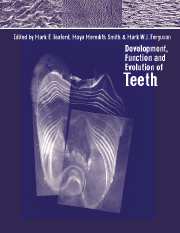Book contents
- Frontmatter
- Contents
- List of contributors
- Acknowledgements
- Part one Genes, molecules and tooth initiation
- Part two Tooth tissues: development and evolution
- Part three Evolution of tooth shape and dentition
- Part four Macrostructure and function
- 16 Developmental plasticity in the dentition of a heterodont polyphyodont fish species
- 17 Enamel microporosity and its functional implications
- 18 Pathways to functional differentiation in mammalian enamel
- 19 Trends in the evolution of molar crown types in ungulate mammals: evidence from the northern hemisphere
- 20 Function of postcanine tooth crown shape in mammals
- 21 Primate dental functional morphology revisited
- Index
17 - Enamel microporosity and its functional implications
Published online by Cambridge University Press: 11 September 2009
- Frontmatter
- Contents
- List of contributors
- Acknowledgements
- Part one Genes, molecules and tooth initiation
- Part two Tooth tissues: development and evolution
- Part three Evolution of tooth shape and dentition
- Part four Macrostructure and function
- 16 Developmental plasticity in the dentition of a heterodont polyphyodont fish species
- 17 Enamel microporosity and its functional implications
- 18 Pathways to functional differentiation in mammalian enamel
- 19 Trends in the evolution of molar crown types in ungulate mammals: evidence from the northern hemisphere
- 20 Function of postcanine tooth crown shape in mammals
- 21 Primate dental functional morphology revisited
- Index
Summary
Introduction
Despite its great hardness and density, enamel has an appreciable porosity. Pore structure affects the mechanical properties of enamel. It also influences the interaction between light and enamel, understanding of which is necessary for development of transillumination techniques for caries detection and for optical matching of restorative materials and tooth tissue. However, interest in enamel porosity has above all been stimulated by the important role played by diffusion of acids and mineral ions in caries formation. Because enamel mineral exists as very small crystals, organised in an elaborate structure, the internal pores are small and variable in form, orientation and distribution. Microscopical information on pore structure tends to be prone to artefact but much information has been obtained by a range of less direct methods. Most studies have employed human or bovine permanent enamel.
Pores in relation to enamel structure
Average porosity and the state of enamel water
Techniques used for estimating the mineral content (and hence porosity) of enamel include quantitative microradiography and measurements of enamel density. Both methods require a knowledge of the density of the apatite crystals of enamel, and in the past it has been assumed that they have the same density as hydroxyapatite (3.15 g/ml). However, recent work (Elliott, 1997), which concluded that enamel apatite has a lower density (2.99 g/ml), suggests that many previous estimates of mineral content may be too low. For instance the much-quoted mineral estimate by Angmar et al. (1963) of 86.2% v/v (based on an apatite density of 3.15) has been revised upwards to 93.1% by Elliott (1997) using an apatite density of 2.99.
- Type
- Chapter
- Information
- Development, Function and Evolution of Teeth , pp. 242 - 251Publisher: Cambridge University PressPrint publication year: 2000
- 25
- Cited by



